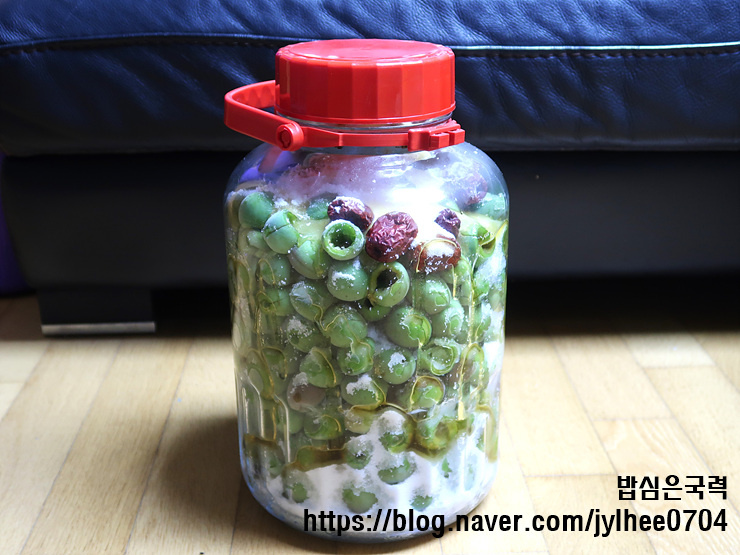Golden Ratio Plum Extract (Maesilcheong) Recipe
Master the Art of Homemade Plum Extract: A Golden Recipe Guide

Discover the ultimate recipe for Maesilcheong (Korean plum extract), a potent elixir known for its detoxifying and strong antibacterial properties, making it particularly beneficial for food poisoning and upset stomachs. This guide provides detailed steps to create a healthy, homemade version.
Ingredients- 5kg of green plums (approx. 3kg after removing pits)
- 2.9kg of white sugar (equal to the weight of the de-pitted plums)
- 100g of rice oligosaccharide (as a sugar substitute)
- 7 dried dates
- 15g of flower salt (to help remove plum toxins and enhance flavor)
Cooking Instructions
Step 1
Start with 5kg of fresh green plums. I received these beautiful plums from a neighbor who picked them herself from the countryside. Green plums are ideal for making plum extract as they have a vibrant, fresh aroma, unlike ripe yellow plums which can become mushy and have a milder scent.

Step 2
To thoroughly clean the plums and remove any pesticide residue or impurities, soak them in cold water with 5 tablespoons of vinegar for 10 minutes. The vinegar acts as a sterilizer. Afterward, sprinkle 5 tablespoons of flour over the plums and gently rub them. Flour is excellent at absorbing and clinging to impurities, making cleaning more effective.

Step 3
Rinse the cleaned plums thoroughly under cold running water until the water runs clear. I rinsed them about 4-5 times to ensure they were completely clean.

Step 4
It’s crucial to dry the plums completely to prevent mold growth in your plum extract. Spread the plums on a drying rack and let them air dry in a well-ventilated area, preferably in the shade, for 3-4 hours until all surface moisture has evaporated.

Step 5
Plum pits can contain a mild toxin, so removing them is recommended for a purer, safer plum extract. You can easily remove the pits using a plum pitter, available at most large supermarkets or kitchenware stores.

Step 6
Using a plum pitter allows you to efficiently separate the pits from the flesh. It took me about 1.5 hours to pit 5kg of plums. The effort invested will certainly result in a delicious batch of plum extract.

Step 7
Here you can see the plums after the pits have been removed. Using a plum pitter also conveniently removes the stems at the same time, making the process more efficient.

Step 8
If you don’t have a plum pitter, you can use a toothpick to carefully remove the small, dark stems. Alternatively, you can make plum extract without removing the pits by pricking the plums all over with a toothpick to help the sugar penetrate better. Another option is to cut the plum flesh away from the pit with a small knife.

Step 9
The standard ratio for plum extract is 1:1 (plums to sugar). However, adding oligosaccharide can speed up the fermentation process. To achieve this, I reduced the sugar by 100g and replaced it with 100g of rice oligosaccharide. White sugar is preferred as it helps maintain the natural flavor of the plums.

Step 10
In a large bowl, combine the de-pitted plums with the sugar, reserving a small amount of sugar to cover the top later. Mix them well. It’s essential to weigh the sugar accurately using a scale; relying on estimation can lead to an incorrect sugar ratio.

Step 11
Soak the dried dates in water for about 5 minutes to loosen any dirt trapped in their wrinkles. Rinse them clean and pat them dry. Dates are added to help neutralize any bitterness from the plums and contribute a smoother, more complex flavor.

Step 12
Layer the plum and sugar mixture into your fermentation jar. Add the prepared dried dates and the flower salt. A small amount of salt helps to draw out any residual toxins and enhance the overall taste.

Step 13
To prevent mold from forming, ensure the top layer is completely covered with sugar. This acts as a barrier against air exposure, which is crucial for preservation.

Step 14
Drizzle the 100g of rice oligosaccharide over the top layer of sugar. The oligosaccharide dissolves more quickly, promoting faster and more active fermentation.

Step 15
Since fermentation produces gas, do not fill the jar completely to the brim. Leave about 20% of the space empty to prevent overflow.

Step 16
When you notice bubbles forming, it indicates that fermentation has begun. After 2-4 days, it’s beneficial to stir the mixture daily or every other day with a clean utensil to ensure even sugar dissolution and fermentation. Release trapped gas by opening the lid every 2-3 days. If white mold appears, carefully skim it off and add more sugar or oligosaccharide. Mold usually indicates insufficient drying of the plums or an inadequate amount of sugar.

Step 17
Loosely cover the jar (do not seal it airtight) and store it in a cool, dark place with good ventilation. Because the pits were removed, you’ll notice the sugar dissolving quite quickly.

Step 18
By the next day, you’ll see a significant amount of sugar has already dissolved! It’s best to let the plum extract ferment and mature for 90 to 100 days. After about 90 days, you can remove the plum and date solids, keeping only the clear plum extract liquid. Once it’s been 100 days or more, transfer the extract into smaller bottles and store it in the refrigerator. The longer it ages, the richer and more complex the flavor becomes. Homemade plum extract, made with care and effort, offers a quality that simply cannot be matched by store-bought versions. Give this rewarding recipe a try!



